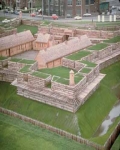Fort Stanwix National Monument
Archaeology »
Archaeological Monuments » Fort Stanwix National Monument
Fort Stanwix National Monument - United States
Fort Stanwix National Monument is located in Rome city,New York.
Fort Stanwix National Monument monument was established on 1762.
Primary threats to Fort Stanwix National Monument :
A reconstructed fort has been built at the site by the National Park Service, and the Fort Stanwix National Monument lies in the center of the modern city.
Historical facts of Fort Stanwix National Monument :
- Fort Stanwix National Monument, located in Rome, New York, is a place of great historical significance in the United States. This national monument preserves the remains of Fort Stanwix, which played a pivotal role during the American Revolutionary War. Here, amidst the reconstructed fort and surrounding grounds, one can uncover a wealth of historical facts that shed light on the struggles and triumphs of the past.
- Fort Stanwix was originally built in 1758 during the French and Indian War. It was named after General John Stanwix, who oversaw its construction. The fort served as a strategic military outpost, guarding the vital waterways and trade routes of the Mohawk Valley. Its location at the western end of the Oneida Carry, a portage route between the Mohawk River and Wood Creek, made it a crucial point of defense and control.
- During the American Revolutionary War, Fort Stanwix gained significant prominence. In 1777, British forces under the command of General Barry St. Leger launched an offensive to capture the fort. The American defenders, led by Colonel Peter Gansevoort, put up a fierce resistance, enduring a prolonged siege that lasted from August 2nd to August 22nd.
- One of the most notable events during the siege was the Battle of Oriskany, fought on August 6th, 1777. American forces, consisting of militia and Oneida allies, attempted to break through the British lines and relieve the besieged fort. However, they were ambushed by a mixed force of British regulars, Loyalists, and Native American warriors. The battle resulted in heavy casualties on both sides and ultimately failed to lift the siege.
- Despite being heavily outnumbered and enduring dire conditions, the American defenders at Fort Stanwix refused to surrender. They employed various tactics, including a successful ruse known as the "Gansevoort's Raid," where they staged a fake sortie to deceive the British into thinking they had received reinforcements. This diversionary tactic helped boost the morale of the defenders and undermined the British siege efforts.
- In a significant turn of events, the siege was ultimately lifted due to the efforts of American forces under the command of General Benedict Arnold. News of a large American army approaching from the west compelled the British to abandon their siege and retreat, leaving Fort Stanwix in American hands. This victory proved crucial in halting the British advance and securing American control over the Mohawk Valley.
- Today, Fort Stanwix National Monument stands as a testament to the fortitude and resilience of the American defenders during the Revolutionary War. The reconstructed fort provides visitors with a glimpse into the past, offering guided tours, interactive exhibits, and living history demonstrations. The monument serves as a reminder of the sacrifices made by those who fought for independence and the enduring legacy of their bravery.
- Exploring Fort Stanwix National Monument allows visitors to connect with the rich history of the American Revolution and gain a deeper understanding of the struggles and sacrifices that shaped the nation. It is a place where the echoes of the past resonate, and where the stories of the men and women who fought for freedom come to life. Fort Stanwix National Monument stands as a beacon of remembrance, honoring the valor and determination of those who played a role in shaping the destiny of the United States.

